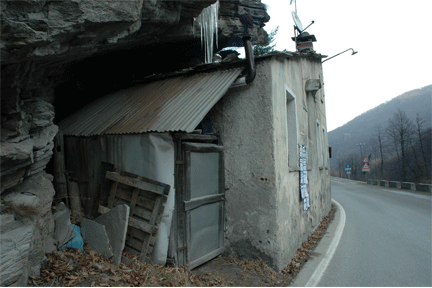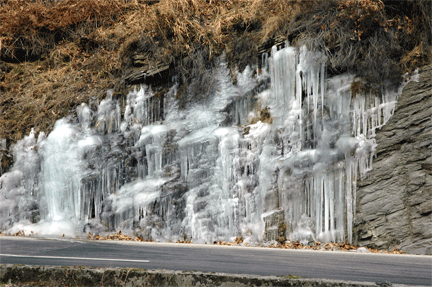One of the more memorable homes we saw in Italy is this little one tucked under a natural ledge on the side of the mountain along Via Cave. I loved the thought of stepping out your front door straight on to the main road each morning. We walked over to see if anyone was home but no luck. Even the washing was frozen. Of all the places to build a house why here?
Another thing you will notice on the walls in Italy are the bulletin boards of death notices. These often black-bordered papers are called necrologie and can be found everywhere …even on tiny houses under mountain ledges.
As we drove along Via Cave we found icicles formed all along the side of the cliff road where the water ran off. No wonder the washing was frozen.
If you know of any memorable homes in Italy I would love to see them.
ciao Lisa
Save
Save
Save
Once when visiting the Cinque Terre with a fairly “busty” friend of ours an old lady wandered over to us and said “si dovrebbe dare un pò del tuo per lei” (forgive me if the translation is a little out), which roughly translates to “You should give some of yours to her”.
The her in question being myself who is not blessed in the bosom department. What made us laugh, and still makes me smile today is the way she walked straight over to us, said this pointing from my friends ample chest to my pitiful one and then wandered away laughing.
I of course had no clue what she had said just got a good idea from the look of delighted outrage on my friends face.
You just have to love the Italians…

The other Cinque Terre moment that stuck in my mind is the tiny balcony filled to the brim with freshly washed soft toys, our daughter spotted Po (the red telly tubby) and Luca saw Pooh Bear and that was the end of our tranquil walk down to the ocean. We had to stop and wave to Pooh and Po and take some photos. Passersby stopped to smile and look up with us, and perhaps remember their own favorite childhood toy.
and the gang x
Salvatore (Sam to anyone not in Italy) finished painting the walls of the Metato – Castagne (Chestnut) room…
Notice the small door (top right hand corner), this is where the chestnuts would be put through onto the mesh for smoking. The walls are covered in a black tar like substance which the locals assure us will never be able to be painted… you can see the beams that held the mesh and the little door above.
Sam came up with a mix of cement, lime and something like bondcrete to bind it all to the wall. First he coated the walls with the watered down bondcrete mix to seal them.
The great thing about dirt floors is you don’t have to worry about drop-sheets!
The “paint” went on with the “paint throwing machine” although we ended up using a brush like the top of a yard broom in the end to get the mix on the walls…
Sam and Carina had great fun putting the ceiling boards in, the upper level is her new “cubby house” … she can get into all the small angled places, hold nails and is learning to use the hammer…our little “reno girl”
We lined the dirt floor and put lining boards on the ceiling, oiled the door (and found the key) and the windows are in.
Life’s Postcards
So what is a Metato?
When you want to know something ask a local.
Joseph grew up in the “Snow White” cottage at Borga Nari, so we asked him about the strange little door in our house. He told us that as children (he had nine brothers and sisters) the family would collect the castagne and dry them in the metato to make flour. “Ahhh so that’s what it’s for” at last we know!
In the metato there would be a mesh floor on the upper level holding the castagne and underneath a couple of smouldering fires.
The chestnuts would be smoked for six or seven weeks (getting turned every couple of weeks) and at the end would have shrunk to a third of their original size.
The flour was used to make bread and was the main source of food for the winter.
The mountains around our house are covered with castagneti (chestnut woods) and for us it is a fun afternoon exercise to roast them in the pan we found… but only a few generations ago they were a staple part of the diet for the locals.
Castagnaccio – chestnut flour migliaccio, a flat firm chestnut cake described as peasant food at it’s best, and a fixture on winter tables …
pic: authentic italy
Related Links
Life’s Postcards
Save















